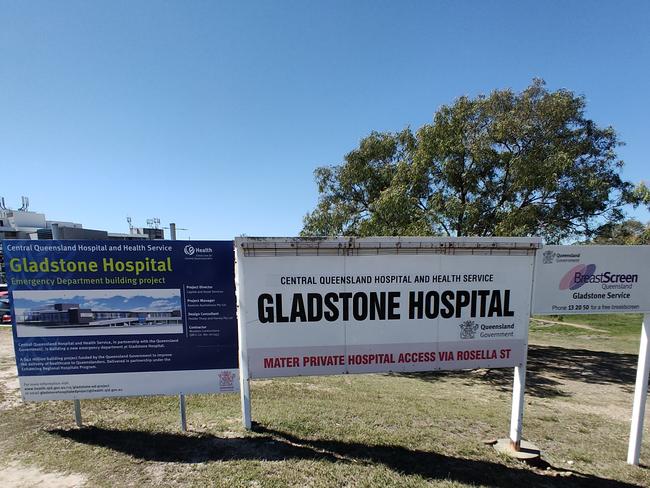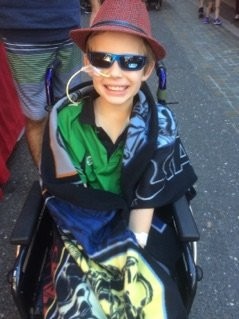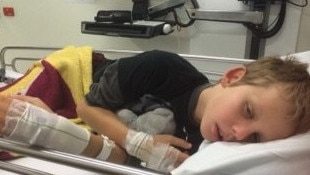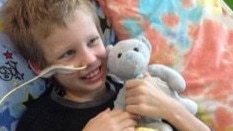Court: Central Queensland Hospital and Health Service to pay Griffith Comrie’s family $2M
When little Griffith Comrie stumbled into his parent’s bedroom with blurred vision, they knew something was terribly wrong. He was rushed to hospital and later discharged, leading to a life-changing diagnosis.
Police & Courts
Don't miss out on the headlines from Police & Courts. Followed categories will be added to My News.
A Central Queensland family has been awarded almost $2 million in damages after their 10-year-old son’s first stroke went undiagnosed and medical experts failed to investigate symptoms to a ‘reasonably competent standard’, leading to a detrimental second stroke.
The boy, Griffith, is now aged 17 and his mother, Sonya Comrie, filed a lawsuit against Central Queensland Hospital and Health Service which was settled in the Supreme Court in Rockhampton by Justice Graeme Crow on September 27, 2022.
Justice Crow awarded the Comries $1,907,363, with $1,475,000 of that being for damages and $432,363 for management fees for Equity Trust which will look after Griffith’s finances when he turns 18.
He also awarded the court costs accrued by lawyers acting in Griffith’s interests – a sum of $170,000.
Documents filed with the court for the lawsuit included multiple expert reports written from hospital records, Griffith’s parents’ affidavits and reports by a speech pathologist and occupational therapists.
The documents outlined a series of failures in the treatment of Griffith, who had entered his parents’ bedroom in Tannum Sands one morning in June 2016, complaining of blurred vision and “stumbling” when walking.
His parents noted he smiled “weirdly” and his father, Todd, took Griffith to the Gladstone Hospital.

Griffith was examined by an emergency department doctor who ordered a CT scan with contrast, the court documents state.
However, the CT scan was performed without contrast and the results were incorrectly reported by the outsourced radiologist from Central Queensland Radiology back to the hospital, the documents stated
From there, Griffith was admitted to the paediatric ward overnight for observations and a paediatrician who reviewed him and his records the next day concluded he had rhinitis (stuffy nose) symptoms and planned for him to be discharged the next day after another review.
Griffith was reviewed on the second day and allowed to go home to recover with a few days off school.
His file noted “plan: discharge back to GP”.
Concerned about Griffith’s changing personality, his father pushed for an earlier appointment for review than what the hospital had proposed.
Twelve days after his first presentation, Griffith was seen by medical staff who prescribed him with vitamin D to be taken orally.

A further 12 days later and Griffith developed acute onset of co-ordination difficulties along with slurred, unintelligible speech.
By the time his father got him to the hospital, Griffith was also complaining of a weak right arm and he had a facial droop.
He was admitted overnight and recommended the next day to have a MRI scan, which had to be conducted in Rockhampton, and the findings of that scan led to Griffith being transported by the Royal Flying Doctor Service to the Lady Cilento Children’s Hospital where the cause of his strokes was identified and treated.
He now takes anticoagulants (blood clot prevention medication) and aspirin regularly.
Now retired paediatric neurologist Dr Michael Harbord reviewed Griffith’s medical files and wrote a report filed with the court for this lawsuit.
His report stated his findings were that Griffith’s first stroke was caused by a tear in the lining of the vertebral artery, resulting in a clot forming at that location and it was likely an emboli (clot or other object) moved through the brain’s circulation system and caused a blockage of blood supply to the right thalamus (near the centre of the brain).

Dr Harbord said this subsequently went on to cause a blockage of blood supply to the left thalamus.
He stated that as the right side one was evident when Griffith first attended Gladstone Hospital with stroke symptoms, the damage to his brain from it was not avoidable and “may have contributed to long-term problems with his learning but would have been much less severe than the subsequent problems caused by” the bilateral damage from two blood supply blocks.
Dr Harbord, in his opinion, believed if the anticoagulants had been given to Griffith after his first CT scan was conducted – if it had been correctly read and reported on – it was likely he would have not had the second stroke.
“The (damage) on both thalami have caused more significant memory and cognitive impairment than would have been the case had only the right thalamus been affected,” he reported.
“In my opinion, at least 50 per cent of his current cognitive difficulties can be attributed to the effect of the left thalamic (damage), specifically because this then meant he has had bilateral thalamic (damage).
“In my opinion, the failure to recognise the (damage) in the right thalamus on the initial CT scan gave a false reassurance to Griffith’s treating doctors, who did not then embark on further brain imaging.”

Meanwhile, Emergency Medicine Physician and associate Professor John Raftos, who also reviewed Griffith’s medical files, found Griffith’s treatment at Gladstone Hospital for the first stroke “was not appropriate or of a reasonable competent standard”.
“The only safe and appropriate medical course of action would have been for the doctors to admit Griffith to hospital for further investigation ... to identify any treatable cause of his neurological deficit.”
He listed a range of blood type tests and other tests he believed should have been undertaken.
Dr Raftos’ report stated Griffith’s CT scan had been read incorrectly.
There was nothing in the documents viewed by this publication to indicate if any actions have been taken over the failures raised in this case, however, there were confidential documents in the court file not available for legal reasons.
The court documents stated Griffith would never be able to live independently due to his disabilities caused by the damage to his brain from the strokes, as he needs supervision for even the simplest daily activities including dressing and personal hygiene, getting out of bed in the morning and eating, closing doors and taking his medications.
The documents also stated Griffith faced “considerable disadvantage when considering employment options available to him” and even if he secured and maintained a job, he would have to be supervised and in a “structured environment with a high degree of routine and repetition” and he would be unable to work in a full-time capacity.
The Comrie family was approached for comment through their lawyers after Justice Crow awarded the settlement, however no response was provided by time of publication.




